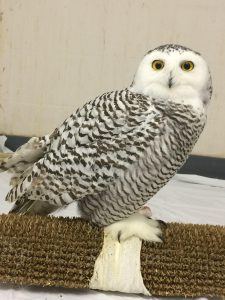
Ohio Wildlife Center Hospital Admits Snowy Owl Injured at Highway Ramp
Update 1/18/2018: This snowy owl has been moved from our Wildlife Hospital to our Pre-Release Facility. It is flying well in a large enclosure. We will continue to monitor its progress and provide periodic updates on the status of the owl. Photos below are of the owl at our Pre-Release Facility taken by Cassandra Swiatek.
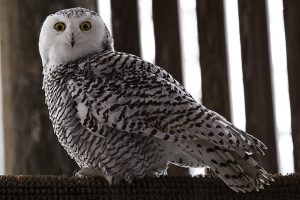
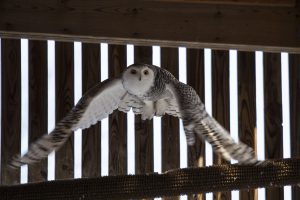
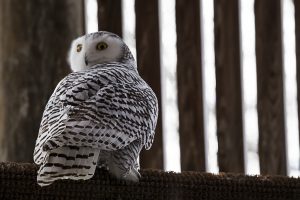
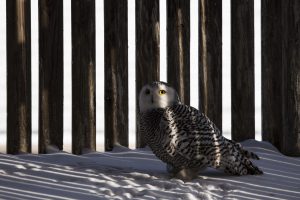
A Columbus driver passing through one of the city’s busiest intersections ended his week rescuing a snowy owl that had been hit by a car at Sawmill Road and I-270 the day after Thanksgiving.
Thomas Gillotte and his mother Tamie Heaney delivered the injured raptor to Ohio Wildlife Center’s Wildlife Hospital at Billingsley Road, less than a mile from the off ramp where the bird was found. The owl’s appearance in Central Ohio is rare, according to Dr. Melinda Marksz, the veterinarian treating the raptor at the Wildlife Hospital. Snowy owls are the largest owls in North America and breed in the arctic tundras of Alaska, Canada, Greenland and Russia.
The snowy owl, a young female, sustained wing and eye injuries most likely from colliding with traffic. It is receiving supportive care and pain control, Marksz said.
Gillotte noticed the injured bird on the highway ramp and could tell it was still alive. He wrapped the owl in a towel and placed it in his truck. “When we arrived at the hospital we told them it was a snowy owl and they couldn’t believe it,” Hegnecy noted.
Records indicate it is the first snowy owl admitted to the Wildlife Hospital in at least 15-20 years. “With an almost five foot wingspan, bright white plumage, a preference for open areas and daytime hunting, snowy owls seem almost untouchable,” said Dusty Lombardi, executive director of Ohio Wildlife Center. “But even these birds are no match for high speed vehicles on highways. Our emergency Wildlife Hospital was this bird’s only option for immediate medical attention.”
The owl’s appearance in Central Ohio is not common, as they typically spend summers hunting in the arctic regions of Alaska and Canada and favor flat, wide open spaces with few trees such as shorelines and fields. Periodic southern migrations of snowy owl flocks, called irruptions, have occurred recently in areas around the Great Lakes. In 2014, an irruption was cited for more than 150 sightings of snowy owls across Ohio. Experts tracking snowy owl migrations are predicting a similar irruption this year, with Michigan currently logging record numbers of owl sightings in the Upper Peninsula.
Snowy owls often perch on fenceposts and telephone poles and fly close to the ground. They feed on waterfowl and small mammals, but lemmings are their preferred food source. The snowy owl now at the Wildlife Hospital is one of 5,200 animals that have been treated this year at the Billingsley Road facility. To help this snowy owl and other raptors at our Wildlife Hospital, donate today.